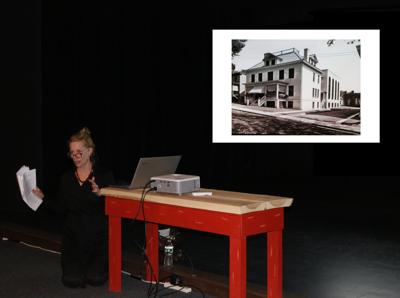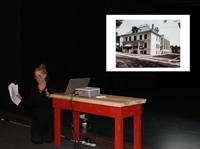Meg Nowack called the Greene County Jail “a rare gem” during a presentation at the Bridge Street Theatre on Saturday.
Nowack, a founding member of Historic Catskill, spoke to a capacity crowd, detailing the historical significance of the former Greene County Jail complex and making the case for its preservation.
Nowack is a Catskill resident and curator for the National Trust for Historic Preservation.
Her presentation, titled “The Completely Fascinating Story of the Old Greene County Jail,” told the story of a building whose architecture was revolutionary for its time and whose cells held more than a few gangsters and bootleggers.
Built in 1908, the jail and the sheriff’s office are listed on both national and state historic registries. The buildings are slated to be demolished, with bid packages expected to go out later this month.
The people who lived and worked in the jail complex and the masons and carpenters who built it deserve to be remembered, Nowack said.
“They built things to last. Demolishing historic buildings, we’re not just demolishing the bricks and mortar. We’re demolishing what they left for us. We’re destroying their legacy,” she said.
The county has explored turning the jail’s land into a parking lot with either 23 or 41 spots, estimated to cost between $1.33 million and $1.9 million.
In her presentation, Nowack showed pictures of the The Smith House hotel, Saint Luke’s Episcopal Church, the 1889 Armory and the Grandview School, all historic Catskill buildings demolished to make way for parking lots.
“It depends on us being more visionary when it comes to our built heritage,” she said. “When something is knocked down, you can’t rebuild it. You have no memory of it. Every human being that touched those buildings goes with them.”
Nowack also spoke of the environmental impact of demolishing historic buildings.
The building’s rubble would end up in a landfill, she said. “Landfills are already at capacity.”
The high-quality stone and wood used to construct the jail are irreplaceable, Nowack said.
The present-day jail complex replaced an earlier jail made of brick and iron, which was said to be impossible to keep free of vermin, according to a 1907 article in the Columbia Republic newspaper that Nowack cited.
When, in 1908, the Greene County Board of Supervisors proposed a new jail, architect William Beardsley of Poughkeepsie bid $126,000 to construct the entire complex. Beardsley’s enterprising wife had her own plans for the old jail. She sold off its iron walls and turned it into a boutique hotel, The Heidelberg Inn.
The new jail’s 30 cells were prefabricated in a factory in Ohio, shipped to Catskill and brought up Bridge Street by horse. Scientific American published an article about Catskill’s pre-made cells, which were revolutionary for providing humane living conditions for prisoners.
The exterior of the jail was built in a neoclassical style to reflect solidarity and security, Nowack said.
“It was meant to inspire confidence in residents of Catskill that no one could escape,” she said.
The new jail, festooned with pinstriped awnings and flower boxes, opened in 1910. State Prison Commissioner George McLaughlin called it “a credit to the county of Greene.”
Over its century of history, the jail held many prisoners, but none more famous than gangster John T. Diamond, known as “Legs” for his skill as a dancer.
Diamond, one of the biggest whiskey and beer bootleggers in the Northeast during Prohibition, was known for his merciless tactics. He is thought to have killed more than 25 people.
Diamond was also a local hero, called a “Champion Against the Drys.” In 1931, throngs of people lined Main Street to see Diamond, still recovering from gunshot wounds, delivered to the jail to serve time for murder.
An evaluation performed by Dutch American Architectural Group in collaboration with Historic Catskill suggests the former Greene County Jail may be the last of its kind. Similar jail complexes built in Oswego County and Jefferson County have already been demolished.
“This building matters for our heritage and has potentially world status as an example of a county jail in iron and steel from the beginning of the 1900s,” according to a report by the Dutch American Architectural Group.
“The facades were never changed and represent a high quality jail of 1908,” the report cites. “All handmade with limited tools. It is rare and of exceptional architectonic value.”
Historic Catskill is a branch of Cultivate Catskill. Its goal is to bring awareness to places of historical value in Catskill, member Amanda Lion said.
Coxsackie Town Historian Michael Rausch provided many of the photos Nowack used in her presentation.









